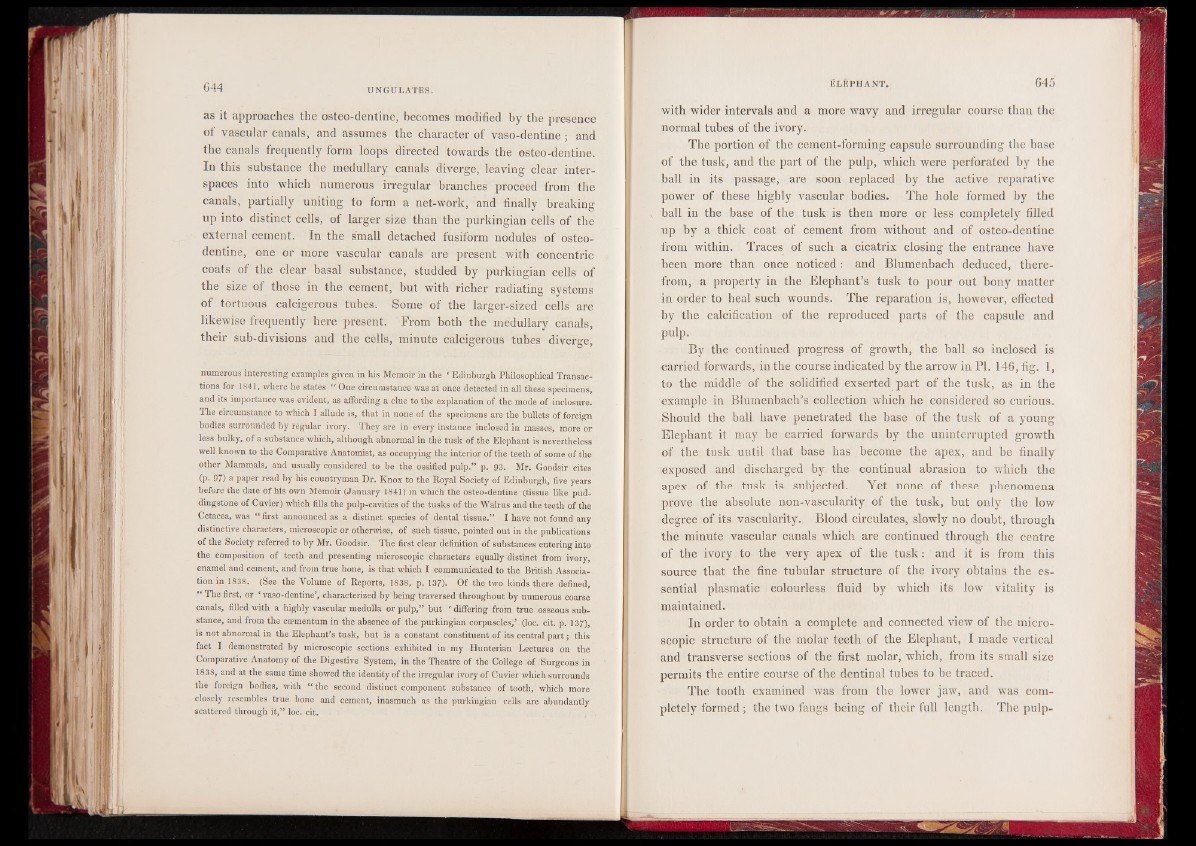
644 UNGULATES.
as it approaches the osteo-dentine, becomes modified by the presence
of vascular canals, and assumes the character of vaso-dentine; and
the canals frequently form loops directed towards the osteo-dentine.
In this substance the medullary canals diverge, leaving clear interspaces
into which numerous irregular branches proceed from the
canals, partially uniting to form a net-work, and finally breaking
up into distinct cells, of larger size than the purkingian cells of the
external cement. In the small detached fusiform nodules of osteo-
dentine, one or more vascular canals are present with concentric
coats of the clear basal substance, studded by purkingian cells of
the size of those in the cement, but with richer radiating systems
of tortuous calcigerous tubes. Some of the larger-sized cells are
likewise frequently here present. From both the medullary canals,
their sub-divisions and the cells, minute calcigerous tubes diverge,
numerous interesting examples given in his Memoir in the ‘ Edinburgh Philosophical Transactions
for 1841, where he states “ One circumstance was at once detected in all these specimens,
and its importance was evident, as-afiording a clue to the explanation of the mode of inclosure.
The circumstance to which I allude is, that in none of the specimens are the bullets of foreign
bodies surrounded by regular ivory. They are in every instance inclosed in masses, more or
less bulky, of a substance which, although abnormal in the tusk of the Elephant is nevertheless
well known to the Comparative Anatomist, as occupying the interior of the teeth of some of the
other Mammals, and usually considered to be the ossified pulp.” p. 93. Mr. Goodsir cites
(p. 97) a paper read by his countryman Dr. Knox to the Royal Society of Edinburgh,'five years
before the date of his own Memoir (January 1841) in which the osteo-dentine (tissue like pud-
dingstone of Cuvier) which fills the pulp-cavities of the tusks of the Walrus and the teeth of the
Cetacea, was “ first announced as a distinct species of dental tissue.” I have not found any
distinctive characters, microscopic or otherwise, of such tissue, pointed out in the publications
of the Society referred to by Mr. Goodsir. The first clear definition of substances entering into
the composition of teeth and presenting microscopic characters equally distinct from ivory,
enamel and cement, and from true bone, is that which I communicated to the British Association
in 1838. (See the Volume of Reports, 1838, p.137). Of the two kinds there defined,
“ The first, or vaso-dentine’, characterized by being traversed throughout by numerous coarse
canals, filled with a highly vascular medulla or pulp,” but ‘differing from true osseous substance,
and from the coementum in the absence of the purkingian corpuscles,’ (loc. cit. p. 137),
is not abnormal in the Elephant’s tusk, but is a constant constituent of its central part; this
fact I demonstrated by microscopic sections exhibited in my Hunterian Lectures on the
Comparative Anatomy of the Digestive System, in the Theatre of the College of Surgeons in
1838, and at the same time showed the identity of the irregular ivory of Cuvier which surrounds
the foreign bodies, with “ the second distinct component substance of tooth, which more
closely resembles true bone and cement, inasmuch as the purkingian cells are abundantly
scattered through it,” loc. cit.
ELEPHANT. 645
with wider intervals and a more wavy and irregular course than the
normal tubes of the ivory.
The portion of the cement-forming capsule surrounding the base
of the tusk, and the part of the pulp, which were perforated by the
ball in its passage, are soon replaced by the active reparative
power of these highly vascular bodies. The hole formed by the
ball in the base of the tusk is then more or less completely filled
up by a thick coat of cement from without and of osteo-dentine
from within. Traces of such a cicatrix closing the entrance have
been more than once noticed: and Blumenbach deduced, therefrom,
a property in the Elephant’s tusk to pour out bony matter
in order to heal such wounds. The reparation is, however, effected
by the calcification of the reproduced parts of the capsule and
pulp.
By the continued progress of growth, the ball so inclosed is
carried forwards, in the course indicated by the arrow in PI. 146, fig. 1,
to the middle of the solidified exserted part of the tusk, as in the
example in Blumenbach’s collection which he considered so curious.
Should the ball have penetrated the base of the tusk of a young
Elephant it may be carried forwards by the uninterrupted growth
of the tusk until that base has become the apex, and be finally
exposed and discharged by the continual abrasion to which the
apex of the tusk is subjected. Yet none of these phenomena
prove the absolute non-vascularity of the tusk, hut only the low
degree of its vascularity. Blood circulates, slowly no doubt, through
the minute vascular canals which are continued through the centre
of the ivory to the very apex of the tusk: and it is from this
source that the fine tubular structure of the ivory obtains the essential
plasmatic colourless fluid by which its low vitality is
maintained.
In order to obtain a complete and connected view of the microscopic
structure of the molar teeth of the Elephant, I made vertical
and transverse sections of the first molar, which, from its small size
permits the entire course of the dentinal tubes to be traced.
The tooth examined was from the lower jaw, and was completely
formed; the two fangs being of their full length. The pulp